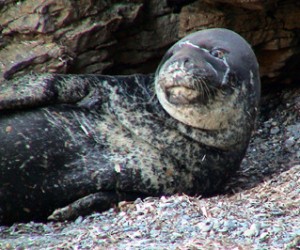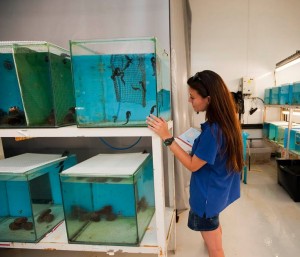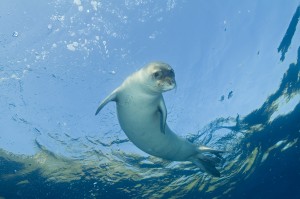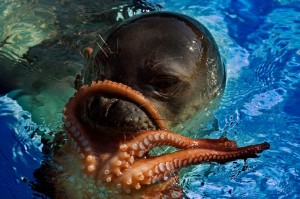
Tell us about yourself…
My name is Ezgi Saydam, and I am from Turkey. I am from a city named Izmir, on the west coast of the country, overlooking the beautiful Mediterranean Sea.
What EDGE species are you working on and why is it important that it is conserved?
My EDGE species is the Mediterranean monk seal (Monachus monachus). The Mediterranean monk seal is a marine mammal from the family Phocidae, or ‘true seals’. The Mediterranean monk seal is the one of the most endangered pinniped species in the world, and is distributed across the eastern Atlantic coast and the eastern Mediterranean coast.

The major threats to the species are: habitat loss; deliberate killings by fishermen; individuals captured as by-catch in fishing gear; and huge reductions in their prey from overfishing and illegal fishing. Other threats are disease epidemics, pollution and inbreeding depression. As a result of all these threats, the IUCN (International Union for the Conservation of Nature) Red List classifies the Mediterranean monk seal as Endangered. The world population of the species is estimated at 500 to 550, while it is considered to be represented by 100 individuals in Turkey. This small, fragmented population in Turkey is listed as Critically Endangered by IUCN, illustrating that importance should be given to the protection of the species and their habitats distributed across the coasts of Turkey.
What do you plan to achieve during your two-year Fellowship?
The project’s overall goal is the effective conservation of the Critically Endangered Mediterranean monk seal population in the Gokova Special Environmental Protection Area (SEPA) through ecological assessments.
The classification of habitats used by the Mediterranean monk seal in the Gokova SEPA will be determined. There is no detailed evaluation of monk seal habitats in this area and there is nothing in the management plan about monk seal conservation for the Gulf of Gokova SEPA. The project will document those habitats for conservation measures. When and how often those habitats are being used will be the key outputs.

First, I will generate an estimation of the local population of monk seals, with the number of individual seals and their gender recorded for the project. Although seals have a large range and utilise different habitats, they use the same breeding caves as long as they feel it is safe. We will have an accurate estimation of the monk seal population in the study area, and how individuals use the available habitats, thereafter will be a baseline for any further studies in the vicinity.
These findings will form recommendations for the management of the socio-economic activities on coast and at sea, as part of the Environment Management Plan. By the end of the project, we will present the recommendations for updating the management plans in Gokova SEPA to the relevant governmental department. Restrictions on the boat traffic, the professional and the recreational fishing activities and the anchoring will be recommended in relation to the habitat sensitivity that my project will reveal.
Most importantly, my project team and I hope to raise awareness among both locals and tourists, especially fisherman, about the importance of the species and its habitats in Gokova SEPA.
Why did you apply for the EDGE Fellowship?
I want to be a scientifically well-trained expert in the near future and use my knowledge to help advocate for the environment and its species. My main purpose is promoting awareness for the protection of wildlife with the hopes of reducing extinctions or reduced populations of threatened species. With this programme, I have developed a new point of view, increased my knowledge of conservation and acquired more field experiences.

In other respects, I have the chance to meet other conservationists who are experienced in their own field and are tackling conservation problems they are facing worldwide, and this provides me an opportunity to learn about the scientific methodology of other practices. I have the chance to improve my skills in all these areas and acquire new ones from completing the EDGE Fellowship programme. After this programme, I will share my knowledge with other people and I will do my best to raise environmental awareness and guide others to sustain current conservation activities.
What did you enjoy most about the EDGE Conservation Tools course?
I enjoyed most the Marine week as, of course, I’m in the marine group! But, also, I really enjoyed in the GIS sessions because it was so fun to create maps that will be used for my own work.
Who is your conservation hero?
My conservation hero is Dame Jane Goodall. She is a British primatologist and UN Messenger of Peace. She is thought to be one of the world’s foremost experts on chimpanzees, and began studying the Kasakela chimpanzee community in Gombe Stream National Park in 1960. Jane Goodall has worked extensively on conservation and animal welfare issues. Her work campaigning for animal welfare issues, and her passion for research and conservation is especially inspiring to me.
